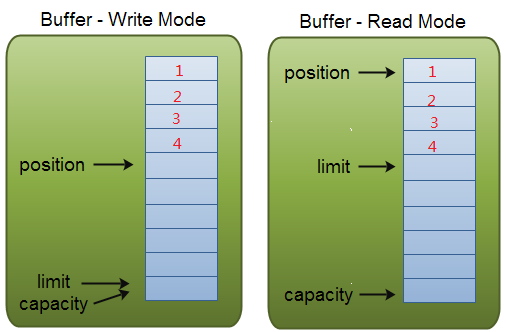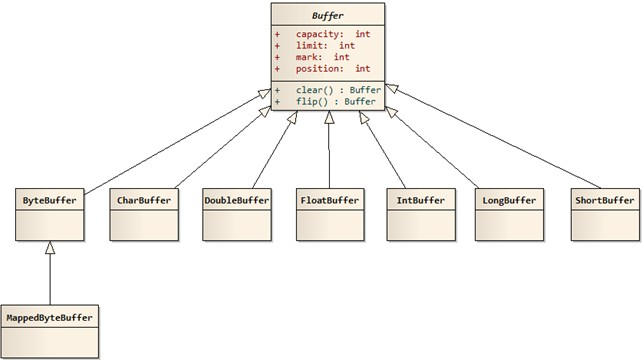Buffer
一块缓存区,内部使用字节数组存储数据,并维护几个特殊变量,实现数据的反复利用。
1、mark:初始值为-1,用于备份当前的position;
2、position:初始值为0,position表示当前可以写入或读取数据的位置,当写入或读取一个数据后,position向前移动到下一个位置;
3、limit:写模式下,limit表示最多能往Buffer里写多少数据,等于capacity值;读模式下,limit表示最多可以读取多少数据。
4、capacity:缓存数组大小
mark():把当前的position赋值给mark1
2
3
4public final Buffer mark() {
mark = position;
return this;
}
reset():把mark值还原给position1
2
3
4
5
6
7public final Buffer reset() {
int m = mark;
if (m < 0)
throw new InvalidMarkException();
position = m;
return this;
}
clear():一旦读完Buffer中的数据,需要让Buffer准备好再次被写入,clear会恢复状态值,但不会擦除数据。1
2
3
4
5
6public final Buffer clear() {
position = 0;
limit = capacity;
mark = -1;
return this;
}
flip():Buffer有两种模式,写模式和读模式,flip后Buffer从写模式变成读模式。1
2
3
4
5
6public final Buffer flip() {
limit = position;
position = 0;
mark = -1;
return this;
}
rewind():重置position为0,从头读写数据。1
2
3
4
5public final Buffer rewind() {
position = 0;
mark = -1;
return this;
}
目前Buffer的实现类有以下几种:
- ByteBuffer
- CharBuffer
- DoubleBuffer
- FloatBuffer
- IntBuffer
- LongBuffer
- ShortBuffer
- MappedByteBuffer
ByteBuffer
ByteBuffer的实现类包括”HeapByteBuffer”和”DirectByteBuffer”两种。
HeapByteBuffer
1 | public static ByteBuffer allocate(int capacity) { |
HeapByteBuffer通过初始化字节数组hd,在虚拟机堆上申请内存空间。
DirectByteBuffer
1 | public static ByteBuffer allocateDirect(int capacity) { |
DirectByteBuffer通过unsafe.allocateMemory申请堆外内存,并在ByteBuffer的address变量中维护指向该内存的地址。
unsafe.setMemory(base, size, (byte) 0)方法把新申请的内存数据清零。
Channel
channel是一个带缓冲的可读可写的I/O对象,所谓带缓冲就是数据要经过一道缓冲的buffer之后,才会到用户层(也就是java代码直接访问的那一层)
目前已知Channel的实现类有:
- FileChannel
- DatagramChannel
- SocketChannel
- ServerSocketChannel
这里用FileChannel做代表吧
FileChannel
FileChannel的read、write和map通过其实现类FileChannelImpl实现。
read实现
1 | public int read(ByteBuffer dst) throws IOException { |
FileChannelImpl的read方法通过IOUtil的read实现:1
2
3
4
5
6
7
8
9
10
11
12
13
14
15
16
17
18
19static int read(FileDescriptor fd, ByteBuffer dst, long position,
NativeDispatcher nd) IOException {
if (dst.isReadOnly())
throw new IllegalArgumentException("Read-only buffer");
if (dst instanceof DirectBuffer)
return readIntoNativeBuffer(fd, dst, position, nd);
// Substitute a native buffer
ByteBuffer bb = Util.getTemporaryDirectBuffer(dst.remaining());
try {
int n = readIntoNativeBuffer(fd, bb, position, nd);
bb.flip();
if (n > 0)
dst.put(bb);
return n;
} finally {
Util.offerFirstTemporaryDirectBuffer(bb);
}
}
通过上述实现可以看出,基于channel的文件数据读取步骤如下:
- 申请一块和缓存同大小的DirectByteBuffer bb。
- 读取数据到缓存bb,底层由NativeDispatcher的read实现。
- 把bb的数据读取到dst(用户定义的缓存,在jvm中分配内存)。
read方法导致数据复制了两次。内核->bb,bb->dst
write实现
1 | public int write(ByteBuffer src) throws IOException { |
和read实现一样,FileChannelImpl的write方法通过IOUtil的write实现:1
2
3
4
5
6
7
8
9
10
11
12
13
14
15
16
17
18
19
20
21
22
23
24
25static int write(FileDescriptor fd, ByteBuffer src, long position,
NativeDispatcher nd) throws IOException {
if (src instanceof DirectBuffer)
return writeFromNativeBuffer(fd, src, position, nd);
// Substitute a native buffer
int pos = src.position();
int lim = src.limit();
assert (pos <= lim);
int rem = (pos <= lim ? lim - pos : 0);
ByteBuffer bb = Util.getTemporaryDirectBuffer(rem);
try {
bb.put(src);
bb.flip();
// Do not update src until we see how many bytes were written
src.position(pos);
int n = writeFromNativeBuffer(fd, bb, position, nd);
if (n > 0) {
// now update src
src.position(pos + n);
}
return n;
} finally {
Util.offerFirstTemporaryDirectBuffer(bb);
}
}
通过上述实现可以看出,基于channel的文件数据写入步骤如下:
- 申请一块DirectByteBuffer,bb大小为byteBuffer中的limit - position。
- 复制byteBuffer src中的数据到bb中。
- 把数据从bb中写入到文件,底层由NativeDispatcher的write实现.
write方法也导致了数据复制了两次,src -> bb, bb-> 内核
Channel和Buffer示例
1 | File file = new RandomAccessFile("data.txt", "rw"); |
注意buffer.flip() 的调用,首先将数据写入到buffer,然后变成读模式,再从buffer中读取数据。
总结
channel里面的那一层缓冲跟传统意义的带缓冲io不同,传统的缓冲io是为了减少io操作,但是channel的缓冲更像是纯粹的把从内核读出来的数据(这数据不在java堆里面)拷贝到java堆中。所以性能不是很好,才会有MappedByteBuffer,下一篇会谈谈这个。

